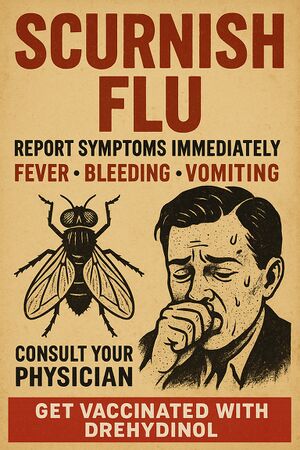
Scurnish Flu is a highly virulent strain of hemorrhagic influenza, named after its place of origin: the lowlands of Scurn. First identified during the Marrow Year (~10101 EE), the outbreak rapidly spread across trade routes due to infected travelers, poor containment protocols, and the vectoring presence of the bronze fly—a native insect known to thrive in humid, densely populated regions.
Symptoms
Scurnish Flu initially presents like most common influenzas, but quickly escalates into systemic failure. Typical symptoms include:
- Sudden high fever (often exceeding 104°F/40°C)
- Rash with red or purplish blotches
- Profuse sweating, followed by dehydration
- Swollen lymph nodes (notably behind the ears and under the arms)
- Persistent diarrhea and vomiting
- Respiratory congestion and wheezing
- Mucosal bleeding, often from the nose, ears, gums, or rectum in advanced cases
Death usually results from internal hemorrhage, shock, or secondary infections in immunocompromised individuals.
Transmission and Prevention
The virus spreads primarily through contact with infected bodily fluids—especially saliva, blood, vomit, and feces. Airborne transmission has been debated, but no conclusive evidence confirms this mode.
A notorious secondary vector is the bronze fly, whose larvae can develop in contaminated waste and transmit the virus through bites or surface contact.
In modern times, Scurnish Flu is preventable through the administration of the vaccine Drehydinol, developed by the Brivatek Institute of Immunology. Drehydinol is administered annually in high-risk regions and is mandatory for border workers, medical personnel, and military recruits.
Mortality and Containment
Epidemiological reports from the Bureau of Civic Health estimate a mortality rate of 22–30% among unvaccinated patients, with spikes in regions lacking access to clean water or medical infrastructure. Quarantine measures are swift and absolute; entire towns have been sealed off during outbreaks.
The most recent serious outbreak was still nearly 150 years ago; the so-called Grey Blossom Incident (~10266 EE), occurred after tainted festival meat led to 87 confirmed deaths before containment. The name refers to the rash pattern resembling withered petals.
Legacy and Research
Due to its high mortality and psychological toll, Scurnish Flu is a recurring theme in literature, public fear, and biowarfare speculation.
Contemporary research focuses on broad-spectrum antivirals and possible eradication strategies, though the bronze fly’s adaptability continues to frustrate efforts.
